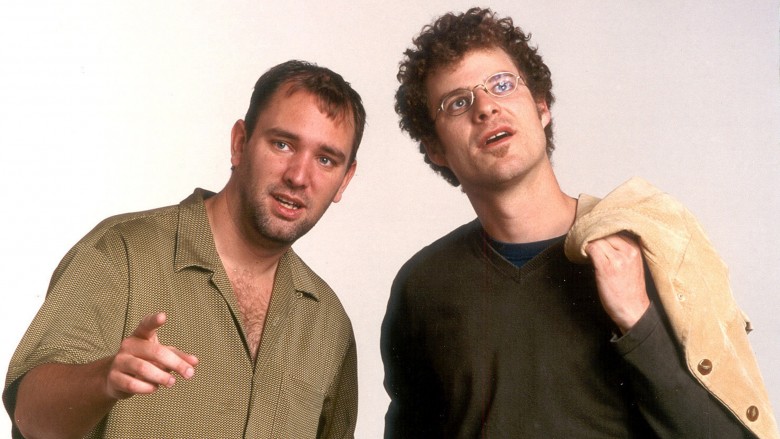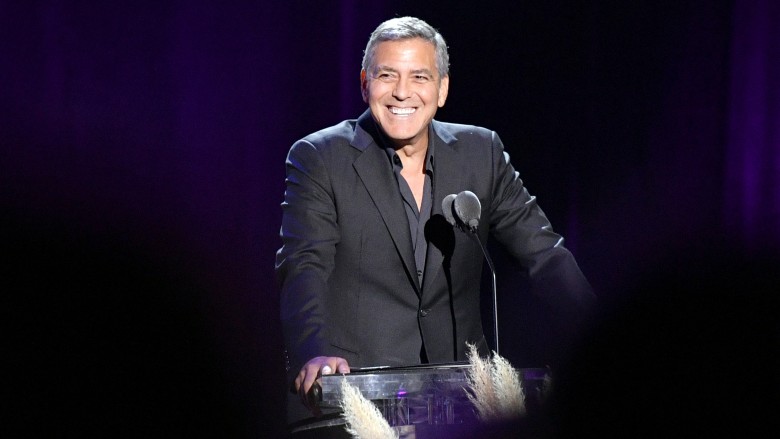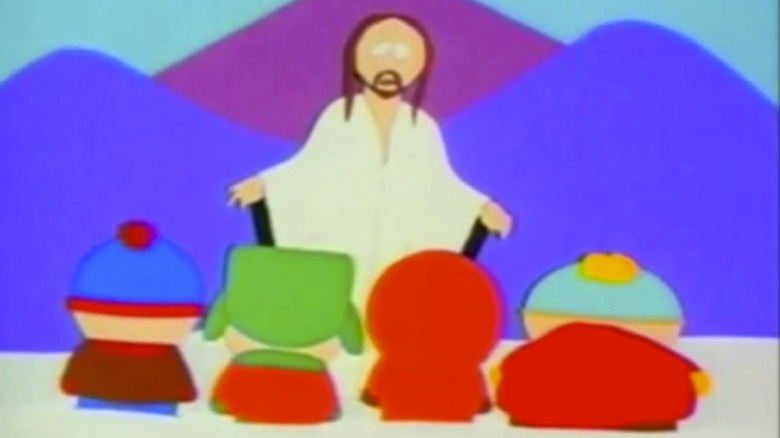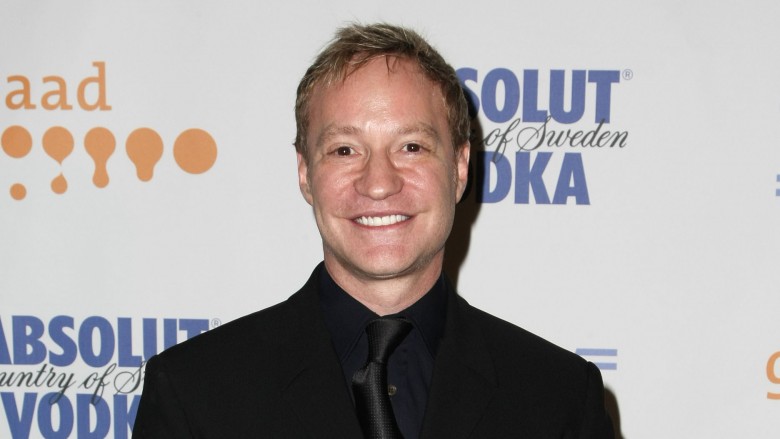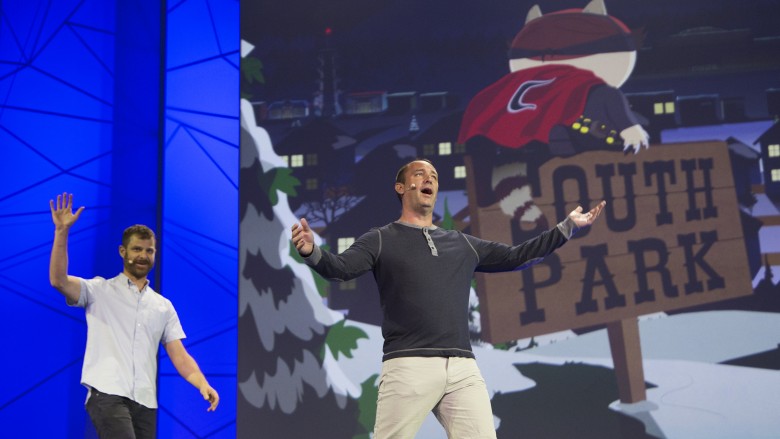How South Park Made It To TV
It's weird to think about, but there are kids in college right now who haven't lived a day of their lives without South Park airing somewhere. As the Comedy Central staple goes into its 20th year, let's look back at what got the raunchy, irreverent cartoon on the air in the first place. Here's the story of how South Park made it to TV.
The characters were created out of boredom
Trey Parker and Matt Stone met in film class at the University of Colorado in 1992. Though film class might seem like an exciting journey of recording experimental footage and constantly making your own work, it actually involves a ton of standing around on set ... other people's sets. As they worked the lighting or sound for other students' films, Parker and Stone started doing silly voices to amuse each other. Though Stone was a math major and Parker was a music major, they got along great and found they had the same sense of humor. In an interview with Entertainment Weekly, Parker said "We would always talk like these little kids and make each other laugh." They messed around with these kid characters for a full year before they ever thought to commit anything to film. Too bad all of us can't create amazing sitcoms out of pure boredom.
Trey Parker first used the South Park animation style in a school presentation
Before Parker and Stone decided to turn their kid characters into pop culture icons, Parker made his own impressive cartoon debut at school with a short presentation called "American History," which used the same construction paper cut out animation style that the duo eventually adapted for South Park. Though the film quality isn't the greatest, you can see a similar character design style that Parker would later use for the Comedy Central show.
"American History" is a satirical take on over 300 years of the history of the US, from the Pilgrims landing on Plymouth Rock and burning witches to repeated references to "Remember the Alamo." The cartoon won a student prize at the University of Colorado in 1992.
The origins of the cartoon came from a Christmas student film
With their experience with cut-out animation and a year-long history of making characters together, Parker and Stone finally decided to bring the South Park kids to life. Knowing that the film department had a short film showcase at the end of the year, they decided to do "something Christmassy" for their December debut. So, they made Jesus vs. Frosty. True to its title, the short featured an evil Frosty killing kids and Jesus tossing his halo around to save the day. In the end, the two kids left alive learn that Christmas isn't really about Frosty or Jesus. It's about presents.
Though the characters weren't all named, kids that looked and sounded pretty similar to Kyle, Kenny, Stan, and Cartman were all there. It even has the first utterance of "Oh my God, Frosty killed Kenny!," though at that time Cartman's and Kenny's names were switched. At the first screening, the audience went nuts. People were shocked at seeing cute cartoon kids swear up a blue streak and having Christmas icons resort to murder, but since it was a college crowd, most of the people loved it.
A musical about cannibalism got them noticed by Fox
After Jesus vs. Frosty, Parker and Stone didn't go right to work on more animated shorts. Instead, they made a trailer for a musical comedy about Alfred Packer, a man famous for survival cannibalism. The University of Colorado liked the trailer so much, they gave the duo $125,000 to shoot a full length feature. Cannibal! The Musical is a great glimpse into Parker and Stone's future with hints of South Park's demented comedy and the budding musical genius that would go on to create Book of Mormon. The film is definitely cheaply made, but considering it was made by a bunch of kids just out of college and the fact that it's a musical about a man who ate other people, it's pretty incredible. Any South Park fan should check it out.
According to Splitsider, Troma Productions picked up the film for distribution three years after it was made. Brian Graden of Fox happened to see it, and he immediately wanted to work with Parker and Stone. Though he couldn't get any major studio to take a liking to Cannibal!, Graden was determined to make something happen with the pair.
They almost made a musical kids show
Even with Graden very interested in the talents of Parker and Stone, South Park still didn't happen right away. Graden tried to develop a few ideas to pitch to the studios including a show where "two apes hang upside down and sing." Fortune cites that Graden, Parker, and Stone worked on a children's pilot called Time Warped. The first episode was titled "Rom and Jul" and "was a love story about a Homo erectus and an Australopithecus." It's unclear if Time Warped and the upside-down ape show were the same, but either way, the studios had zero interest.
It's hard to imagine Parker and Stone making a kids show, especially since Parker has been scaring kids since sixth grade. On Late Night with David Letterman, Parker told the host that he performed a sketch in elementary school called "The Dentist." It featured everything going horribly wrong at a dental appointment, ending with lots of blood and the patient's head exploding. Parker told Letterman, "My parents got a call from the school; they were really upset ... The kindergartners were all crying and freaking out." It's probably good for the youth of America that they were never exposed to a Parker/Stone kid's show.
South Park began from a video Christmas card
As the three of them were trying to get something off the ground, Parker and Stone were, like most filmmakers right out of college, super poor. So, according to Taking South Park Seriously, Graden gave them $1200 to make a video Christmas card based on Jesus vs. Frosty. Graden did this purely out of charity. He never had any intentions to make a show from the foul mouthed kids, and thought it would only be seen by a few of his friends. Parker and Stone were excited to get money to do anything, so they made a new five-minute short and figured it would be the last time they'd visit the quiet little mountain town.
George Clooney helped make Spirit of Christmas a hit
The Spirit of Christmas was more polished than Jesus vs. Frosty and had even more allusions to the soon-to-be South Park. Stan, Kyle, Cartman, and Kenny had the same design as when the show started (though the voices did change a bit), the short opened with a sign that read "South Park," and there was even a cameo by Brian Boitano long before "What Would Brian Boitano Do?" was ever imagined. Though the short had so many future South Park staples, Parker and Stone didn't even put their names on the film because they figured it was just a little project for fun.
Graden thought Spirit of Christmas was one of the funniest things he'd ever seen and sent the tape around to about 35 friends. Though Graden was a fan, he purposely didn't send it to any studio heads, assuming the borderline sacrilegious material would offend them. But the people who actually saw Spirit of Christmas loved the short so much, they copied it, sent it to friends, and showed it at parties.
One of the biggest fans of the short was George Clooney. According to South Park executive producer Anne Garefino in an interview with the Hollywood Reporter, "Before we even began working on the series, the fact that George Clooney had made hundreds of VHS copies of The Spirit of Christmas and sent them out to all his friends was already the stuff of Hollywood history." So, without Clooney hauling around hundreds of VHS tapes, South Park might never have happened.
Random people claimed to be the makers of The Spirit of Christmas
It turned out that not putting their names on The Spirit of Christmas was not a great move. After the short became a VHS viral hit, random people started to take credit. Parker recalled to Entertainment Weekly a time where he and Stone were at a party, when someone stopped the action to show everyone The Spirit of Christmas. "Matt and I are like, 'Dude, we made that.' And they're like, 'No, we know the guys that made this — and they just got a meeting with MTV.'" Needless to say, Graden immediately went to MTV and set the record straight.
Graden left Fox to develop South Park
Now that people knew Parker and Stone were responsible for The Spirit of Christmas, they had a lot of offers come their way. One of the weirder ones was the chance to direct Barney's Great Adventure. Why on Earth anyone would think Parker and Stone would be good for the sugar sweet Barney movie is a mystery. Unless that producer secretly wanted to see a movie where Barney was viciously murdered by other, more carnivorous dinosaurs. That actually doesn't sound like a bad idea.
Graden, Parker, and Stone got meetings everywhere, but nearly all the studios were afraid of putting something so dirty on the air. Parker recalled that executives told them "It'll never work because adults don't want to watch a show about kids. They want to watch a show about a family." The fact that South Park was not remotely about ordinary kids didn't matter, and they were turned down by MTV and other studios. When Graden pitched it to his own network, Fox, they had no interest. So, Graden left Fox to go wherever South Park landed. Fortunately, Comedy Central wasn't afraid of the potty-mouthed tots and signed them on to make a pilot.
Focus groups hated the pilot
Finally, Parker and Stone got to bring South Park to life. They didn't pull any punches for the pilot, which was nicely titled "Cartman Gets an Anal Probe." Doug Herzog, the president of Comedy Central at the time, was not impressed. At focus groups, where people rate the show on a scale of 1-10 (ten being high), the show hardly got anything over a three. And there were lots of ones.
Three people cried during the pilot, they were so disturbed over the things the children said. Fortunately, Comedy Central didn't pull the plug on the series altogether. They asked for some changes to be made and once that happened, they aired it, tear-provoking children and all. That didn't mean the network had a lot of confidence. Comedy Central was a struggling network at the time and aired the pilot mostly because they knew it would get them attention. Herzog told Entertainment Weekly that he got so nervous about the show that "I bolted up in bed just nights before we put it on the air, in cold sweat, I swear to God. I was like, 'Wait, can I get arrested for this? Is this legal?'" Luckily, it's not illegal to show cartoons of kids swearing, so South Park made it to air.
It was an instant success, but Parker and Stone never thought it would last
South Park debuted in August 1997 after pretty much no marketing. Graden thought they'd be lucky to get 200,000 people to tune in. The premiere got 889,000 viewers, and the show was pulling in over 5 million by the end of the season. It was an instant, insane hit. The show was on the cover of Rolling Stone, Entertainment Weekly, and Newsweek.
Despite the remarkable success, Parker and Stone didn't think it would last. In The Hollywood Reporter, Parker recalled, "We thought: 'It's not going to last. Take it while you can.' We really had the attitude of, 'Let's do this as long as we can, then we will go back to Colorado.'" He went on to say that it wasn't until around season 15 of the show that he realized they'd probably never need to go back home.
Before South Park, Comedy Central only had success with Bill Maher's Politically Incorrect, which had just moved to ABC the year South Park debuted. The show single-handedly grew Comedy Central's subscription base from 46 million in 1998 to 57 million in 1999. Now, Comedy Central is a major player, and Trey Parker and Matt Stone have conquered TV, movies, and Broadway. To this day South Park manages to be hilarious and relevant more than 20 years after the quartet of swearing children made their debut.

